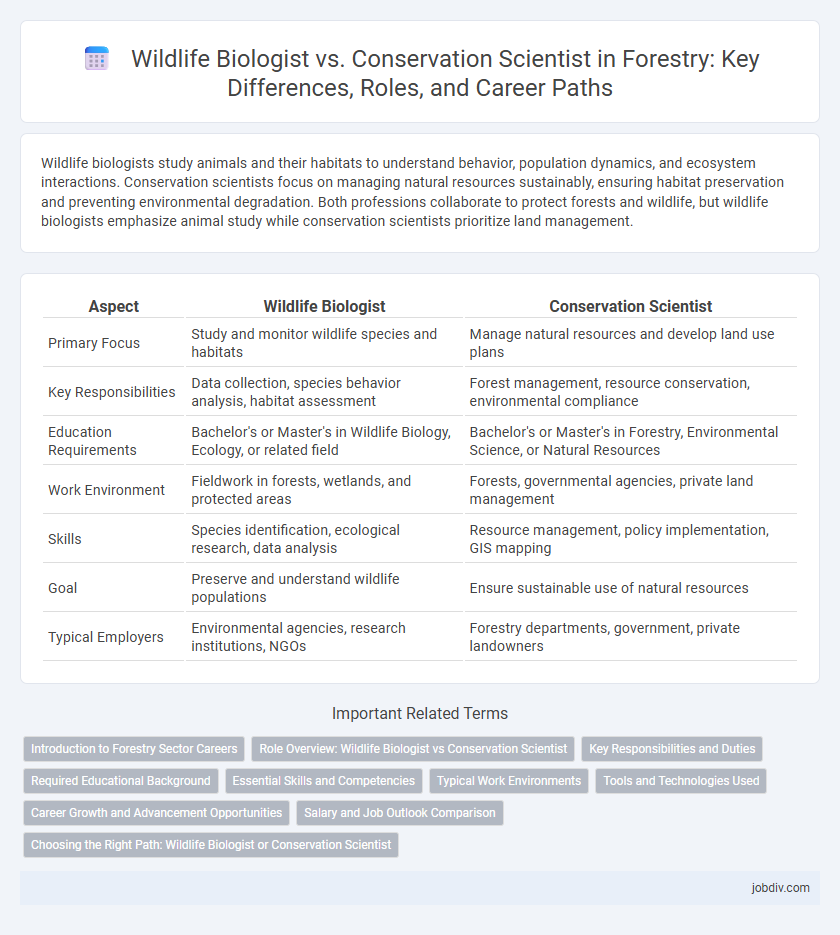Wildlife biologists study animals and their habitats to understand behavior, population dynamics, and ecosystem interactions. Conservation scientists focus on managing natural resources sustainably, ensuring habitat preservation and preventing environmental degradation. Both professions collaborate to protect forests and wildlife, but wildlife biologists emphasize animal study while conservation scientists prioritize land management.
Table of Comparison
| Aspect | Wildlife Biologist | Conservation Scientist |
|---|---|---|
| Primary Focus | Study and monitor wildlife species and habitats | Manage natural resources and develop land use plans |
| Key Responsibilities | Data collection, species behavior analysis, habitat assessment | Forest management, resource conservation, environmental compliance |
| Education Requirements | Bachelor's or Master's in Wildlife Biology, Ecology, or related field | Bachelor's or Master's in Forestry, Environmental Science, or Natural Resources |
| Work Environment | Fieldwork in forests, wetlands, and protected areas | Forests, governmental agencies, private land management |
| Skills | Species identification, ecological research, data analysis | Resource management, policy implementation, GIS mapping |
| Goal | Preserve and understand wildlife populations | Ensure sustainable use of natural resources |
| Typical Employers | Environmental agencies, research institutions, NGOs | Forestry departments, government, private landowners |
Introduction to Forestry Sector Careers
Wildlife biologists study animal behavior, habitats, and ecosystems to protect and manage wildlife populations within forest environments. Conservation scientists focus on developing sustainable land-use practices that balance forestry production with natural resource preservation. Both careers are integral to the forestry sector, ensuring ecological health and biodiversity while supporting economic and environmental sustainability.
Role Overview: Wildlife Biologist vs Conservation Scientist
Wildlife Biologists primarily study animal behaviors, habitats, and populations to inform species management and conservation efforts. Conservation Scientists focus on managing natural resources, developing land use plans, and ensuring sustainable forestry practices. Both roles contribute to ecosystem health but differ in emphasis, with Wildlife Biologists centered on fauna and Conservation Scientists on overall habitat and resource sustainability.
Key Responsibilities and Duties
Wildlife biologists primarily study animal species and habitats to understand behavior, population dynamics, and ecological impacts, conducting field research, monitoring wildlife health, and advising on species protection. Conservation scientists manage natural resources by developing land use plans, assessing environmental impact, and implementing sustainable practices to preserve forests, soil, and water quality. Both roles collaborate to balance ecosystem health with human activity, but wildlife biologists focus more on fauna, while conservation scientists emphasize habitat conservation and resource management.
Required Educational Background
Wildlife biologists typically require a bachelor's degree in wildlife biology, zoology, or ecology, with advanced positions often demanding a master's or doctoral degree in related fields. Conservation scientists generally hold degrees in environmental science, forestry, or natural resource management, emphasizing coursework in soil science, biology, and ecosystem management. Both professions value field experience and specialized training in habitat assessment, species identification, and environmental regulations.
Essential Skills and Competencies
Wildlife biologists require expertise in animal behavior, habitat assessment, and species monitoring to study and manage wildlife populations effectively. Conservation scientists need strong skills in land management, environmental policy, and ecosystem restoration to develop sustainable practices for natural resource use. Both roles demand proficiency in data analysis, field research techniques, and knowledge of ecological principles to support conservation and forestry management goals.
Typical Work Environments
Wildlife biologists typically conduct field research in diverse natural habitats such as forests, wetlands, and grasslands to monitor animal populations and ecosystems. Conservation scientists often work in a blend of outdoor environments and office settings, focusing on managing natural resources and developing land-use plans for sustainable forestry practices. Both professions collaborate with government agencies, environmental organizations, and landowners to promote biodiversity and habitat preservation.
Tools and Technologies Used
Wildlife biologists use GPS tracking collars, camera traps, and acoustic monitoring devices to study animal movements and behaviors in their natural habitats. Conservation scientists utilize geographic information systems (GIS), remote sensing technology, and environmental modeling software to assess ecosystem health and develop sustainable land management plans. Both professionals rely on data analysis tools to evaluate environmental impacts and guide conservation efforts effectively.
Career Growth and Advancement Opportunities
Wildlife biologists often progress through field research roles to senior ecologist or project lead positions, benefiting from specialized expertise in animal behavior and ecosystem interactions. Conservation scientists typically advance by managing natural resource projects or influencing policy development, leveraging their skills in land management and environmental compliance. Both careers offer opportunities in government agencies, environmental organizations, and private sectors, with growth dependent on experience, further education, and technical proficiency.
Salary and Job Outlook Comparison
Wildlife biologists typically earn a median annual salary of around $66,000, while conservation scientists have a slightly higher median salary near $70,000, reflecting differences in job responsibilities and education requirements. The job outlook for wildlife biologists is projected to grow by 5% over the next decade, aligned with increasing environmental awareness and wildlife management needs. Conservation scientists face a slower growth rate of about 3%, influenced by budget constraints in land management and conservation programs.
Choosing the Right Path: Wildlife Biologist or Conservation Scientist
Selecting between a Wildlife Biologist and a Conservation Scientist hinges on career focus: Wildlife Biologists primarily study animals and their habitats, employing field research and behavioral analysis to protect species. Conservation Scientists manage natural resources by developing land use plans and policies that promote sustainable forestry and ecosystem health. Understanding specific interests in animal behavior versus resource management ensures the right professional path for effective forestry conservation.
Wildlife Biologist vs Conservation Scientist Infographic

 jobdiv.com
jobdiv.com